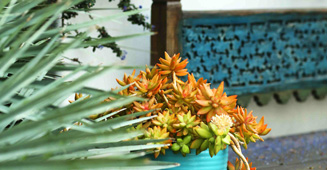

Contributor
- Topics: Archive

How would you define a successful residential landscape?
As a professional landscape designer, I’ve heard many responses to this question. Wish lists from clients often include: shade, privacy, areas for food production and preparation, increased property value, spaces to entertain and relax, play spaces for children and dogs, parking, storage, greenery—all design pieces to be puzzled together beautifully.
Residential property is often a heavily used and maxed-out plot of land. A successful design starts with good analysis; add in creativity, building material selection, and a substantial dose of sensibility to envision the future space and make an art of it. What will it look like in one year, five years, or ten years? How will plants appropriate to the site conditions be artfully installed to provide habitat and forage for native and migrating insects and birds? What irrigation and drainage systems will contribute to healthy soil and the environment? Deeper still, the design must engage on an emotional level, activating that child-like wonder for the outdoors that we have all experienced at some time in our lives.
Good design is clearly essential, but quality maintenance will determine if that design reaches its potential, preserving the value of the client’s initial investment. I believe the success of a residential landscape depends upon the designer remaining involved with the project on an ongoing basis. Sharing stewardship with the homeowners helps achieve a more lasting state of ecological and aesthetic sustainability.

As the landscape settles and matures, the designer’s role becomes that of a choreographer, directing growth of shrubs and trees, editing when necessary, and ensuring that problems like pests or faulty systems are detected early and dealt with efficiently. Periodic site visits are necessary to assess and make recommendations regarding tree pruning, horticultural detailing, and other necessary maintenance. These continuing visits help the designer and client to form a trusting relationship that leads to a mutual and intimate understanding of the processes at work as the garden evolves.
The passage of time intensifies the pleasure one derives from nature. Gardeners know this, but most clients aren’t gardeners. Watching a bulb or vine rebloom year after year, or a sapling attain stature and bear fruit is when the connection to nature truly deepens. It’s particularly fulfilling when both the client and designer share that link with the garden.

Casa de los Arcos
This is the story of a special project. In 2006, owners Susan Kandel and Peter Lunenfeld hired me to redesign and transform their property. Both are writers who spend a good deal of time working at home. I recall them saying they had decided to improve upon what they had rather than moving away from their densely urban West Hollywood neighborhood to obtain more square footage. I liked that approach, and we all liked their 1934 Spanish Revival style architecture with its detailed arches and bay windows. All it needed was…revival.
What I encountered that first day was essentially dying shrubbery and a muddy hole in the backyard where a new pool was being installed with its equipment placed maladroitly off the driveway in plain sight. The beautifully crafted home was hidden behind overgrown foundation plantings and the rest of the front yard had been abandoned to the street. “Because of the poor grading, the back felt like a muddy swamp,” Susan observed. “We had outgrown our house, but couldn’t figure out how to make use of the outdoor spaces. And we’d had no success in making any fruits or vegetables grow.” I was faced with a marvelous challenge.

I developed a concept plan that embraced the functional aesthetic of the Mission Era courtyard with the decorative influence of early California Style. My approach was to revive the soil and breathe life into a series of dormant spaces. Stormwater was directed into infiltration areas and volume was established with vertical plantings. An early decision was made to re-stucco the house so we’d have a clean slate. Built-in seating and a fire pit in the pool area executed in a simplified color palette streamlined an active area for play and entertaining in the back. A deep blue fence and decorative carpentry screening the garage wall and pool equipment provided a backdrop for a new dining area with outdoor grill and bar with herb and fruit gardens along the driveway.
In the front of the property, one of the most successful design decisions was the creation of a courtyard garden with an octagonal Catalina-inspired tiled fountain surrounded by textured plantings. The porte-cochere, formerly used for storing trash, was repurposed as a setting for a wonderful Moroccan urn. A strong oblique fence line provided side-by-side off-street parking and created a recessed entry and dynamic sightlines from the house in several directions. The addition of Moorish outdoor lighting completed the transformation.

Susan and Peter were fully engaged in the process, which contributed significantly to the success of the project. As Peter notes, “Both Susan and I have a lot of professional experience with artists and designers. We respect the process and understand that the best projects emerge from a constant dialogue between designer and client.”
Once installed, any new garden holds the promise of the designer’s vision. But without continued direction and editing, there is less likelihood that, over time, the maturing garden will reflect the original plan’s potential. Happily, Susan and Peter have kept me on their team, stewarding their patch of the urban quilt.

A garden is a living thing. It breathes, grows and needs care. Trees steal light by taking on mass; vines need wrangling to cover structures, and shrubs need pruning to control their shape. At Casa de los Arcos, the plan called for espaliered ceanothus, fig, and pomegranate, which take several years to establish form. I brought in a date palm to stand in as an “umbrella,” a process that took a couple of years to fully open to create a natural canopy over the seating area adjacent to the pool. To shade the clients’ bedroom window that gets sun year-round, I draped an evergreen bougainvillea on a wrought-iron awning. Over their writing studio door, a wisteria leafs out for the hot summer when they need shade, but provides light in the winter by going deciduous, clearly demonstrating to my clients that, at its best, landscape design is a time-based art form that requires subtle observation, interpretation, and action.

Over the years, I have seen Peter and Susan become ever more attuned to their garden and its rhythms. It makes me happy to listen to them share their observations and I, in turn, share my knowledge of horticulture with them. I have received enthusiastic calls about the night-blooming cereus, been texted pictures of an iridescent chrysalis, and been invited over to celebrate the arrival of monarch butterflies.

A successful landscape is one that becomes more resonant with age. It encourages participation rather than just spectatorship. It delights and surprises with seasonal change, animation, and sustenance.
As Peter says, “We’re not gardeners by nature or inclination, but we’ve come to a much deeper understanding of the cycles of nature and the pleasure of pausing to be in a landscape through our participation in the garden.”
Share:
Social Media
Garden Futurist Podcast
Most Popular
Videos
Topics
Related Posts

Low Maintenance Gardens – Better for Pollinators and People
Autumn 2022 “I come out every day. It’s therapy, my meditation.” Janet’s young garden transformed from overgrown, invasive plants to mostly natives. The dailiness of

Invasive Plants Are Still Being Sold: Preventing Noxious Weeds in Your Landscape
Autumn 2022 With so many beautiful ornamental plant species and cultivars throughout California and the Pacific Northwest, how do you decide which ones to include

Garden Design in Steppe with Transforming Landscapes with Garden Futurist Emmanuel Didier
Summer 2022 Listen to full Garden Futurist: Episode XVII podcast here. Emmanuel Didier, Principal and Creative Director at Didier Design Studio is a leading figure

Seslerias: Versatile Groundcover Meadow Grasses
Summer 2022 Without question, the most beautiful and versatile of all the groundcover meadow grasses are the moor grasses (Sesleria). Moor grasses tick off all









Responses